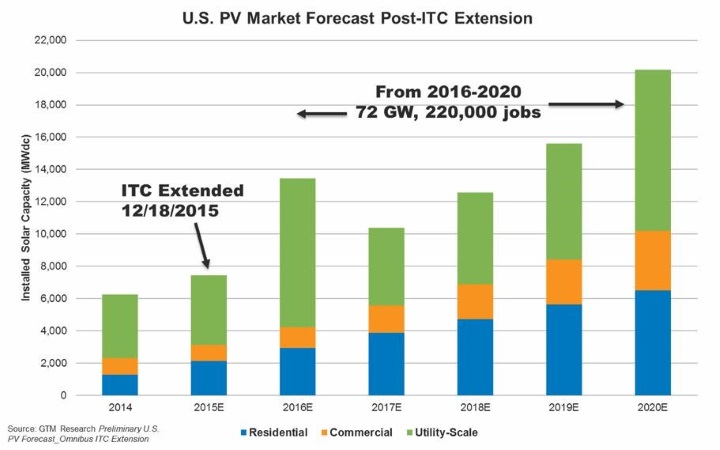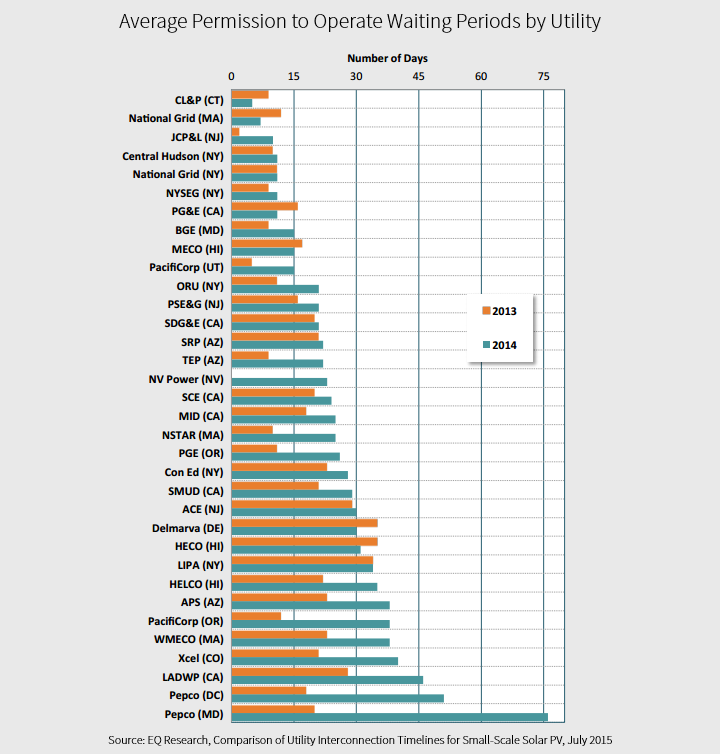While extension of the Investment Tax Credit (ITC) is expected to relieve some of the pressure for new solar photovoltaic (PV) interconnections in 2016, the long-term outlook is for overall stronger growth for all types of projects, including residential PV. As a result, utilities will be facing an unprecedented increase in distributed PV system interconnections for years ahead as prices continue to drop, and customers seek to capture the substantial tax breaks provided by the ITC. When combining solar with other distributed energy resources (DERs) like storage, electric vehicles (EVs) and smart devices, the return on investment can be even greater, creating even more challenges and opportunities for utilities.
The long-term solar PV volume increase represents a paradigm shift for utilities that may have been looking at short-term solutions to handle the expected rush of interconnection applications in 2016 had the ITC expired. The growing number of requests will create a strain on utilities that lack the systems, processes and resources to efficiently accept and process high volumes of interconnection applications. As energy consumers look increasingly to utilities for answers about solar and DER investments, utilities will have a greater need to effectively engage customers and reliably integrate these resources into the grid.
No matter the size of the utility, the growth in solar and other DERs will be felt, so the time is now to prepare to integrate them more effectively. Fortunately, there are cloud-based tools available today to help address these challenges.
ITC extension and new distributed energy resources driving growth
The federal tax credit will remain at 30% through 2019 before stepping down to 26% in 2020, 22% in 2021 and finally 10% in 2022. The Solar Electric Industry Association (SEIA) and GTM Research estimate an additional 72 GW of capacity to be installed in the U.S. by 2020, fueling more than 220,000 new jobs during the same period.

Analysts predict that combined DERs such as solar and storage will be a disruptive force on utility business models, not only as a driver of continued solar growth, but also in terms of how these technologies impact grid operation. While solar and DER growth is promising news for supporters, it creates additional concerns for utilities that have to manage more solar and other DERs, while maintaining power quality and containing costs.
Onboarding Solar: Avoiding a growing backlog of projects.
The number of projects in a utility’s queue can affect its ability to process applications. According to an EQ Research study, the length of time it took to obtain permission to operate (PTO) increased from a range of 2 to 35 days in 2013, to a range of 5 to 76 days in 2014. The median waiting period jumped from 18 days to 25 days during the same time.

While the trend cited was for 2013 to 2014, anecdotally we saw this trend continuing at many utilities in 2015. There are notable exceptions, however, where automation of interconnection processes through the use of cloud-based software such as PowerClerk® resulted in substantial improvements. Examples include:
- A large utility in California reconfigured their interconnection management process, bringing their time to interconnect from an average of 45 days to only 3 days. The new online submission process made this possible by optimizing workflows, such as: eliminating the need for the utility to manually transcribe information, by reducing the number of touchpoints during the review process, and by facilitating collaboration between departments.
- NV Energy reduced average time to interconnection by 63%, or about three weeks, by using PowerClerk. Key to faster processing times for NV Energy is the use of electronic signatures, which eliminates delays caused by mailing applications for “wet” signatures.
- The Energy Trust of Oregon was able to process many more incentive applications without adding staff–scaling from a few-hundred applications per year to more than 1,000 applications per year with one full-time employee.
- An investor-owned utility in the Northeast is integrating PowerClerk with its internal IT systems to reduce applicant errors and streamline the technical review process. Specifically, the integration will enable: automatic validation and auto-population of customer account information into interconnection applications; automatic generation of meter-set requests; and automatic input of circuit information (including available capacity) directly into the technical review form.
These are just a few examples from the many customers that are finding similar success in reducing interconnection processing times and administration costs by taking their processes online.
Another increasingly-common challenge utilities face is keeping home and business customers informed about whether or not they will qualify for a particular NEM tariff—before a decision is made to install a PV system. When not managed well, the transition from one rate to another can come as a surprise to customers who learn too late that their newly installed PV system is not going to be on the expected NEM tariff.
In this situation, the ability to queue applications as they come in, update customers in real-time and keep all stakeholders informed via dashboards—all possible with cloud-based software tools like PowerClerk—can lead to greater transparency and higher levels of customer satisfaction.
Engaging utility consumers about solar and DER options
With so many energy options available today, consumers are looking to their electric utility for information and guidance. When considering, for instance, installing a PV system or purchasing an EV, questions inevitably arise around the costs and potential electric bill savings, how a new electric rate may affect the return on their investment, or whether they can save even more by combining technologies such as solar plus an EV, or solar plus storage.
Utilities are uniquely positioned to aid consumers in making smart decisions about their energy investments, and it’s more important than ever for utilities to find ways to engage their customers about these and other questions with personalized, accurate information. Today, new, cost-effective software tools such as WattPlan® are available that allow customers to find answers on the web, at their convenience, right from a utility website.
Utilities have much to gain from helping their customers make informed DER purchase decisions. For example, as more consumers purchase an EV, utilities will realize a greater demand for electricity. When combined with renewables like solar, EV charging also represents a significant opportunity to soak up excess generation during periods of high renewables production, and a fast and significant demand response resource during periods of renewable generation intermittency.
Reliably integrating behind-the-meter PV
As penetration of solar increases, power quality issues arise around voltage regulation and variability, especially on cloudy days. Research has shown that the ability to forecast behind-the-meter, distributed PV systems using software such as SolarAnywhere® FleetView®—and feed that information into load balancing tools—improves the quality of utility load forecasts. This is important to maintaining grid reliability and managing the cost of imbalance in high-penetration PV scenarios.
In order to stay ahead of this need, utilities should be creating a system-of-record that tracks all PV systems interconnected to the grid. This information can then be used to generate equipment and location-specific forecasts for use in planning and load balancing. The ideal time to capture this information is the time of interconnection via online tools such as PowerClerk.
Conclusion
With the extension of the ITC, there is no doubt about the continued growth of solar. To stay ahead of the game, utilities should be thinking now about every stage of integration—from engaging and guiding consumers in their purchase decisions, to efficiently processing interconnection applications, and integrating behind-the-meter forecasts into balancing area forecasts—and taking advantage of tools available today to prepare for the future.
If you’re exploring ways to meet the growing needs for engaging customers, rapidly processing interconnection applications, or managing a higher penetration of solar PV, we welcome a conversation to see how our tools may help.
